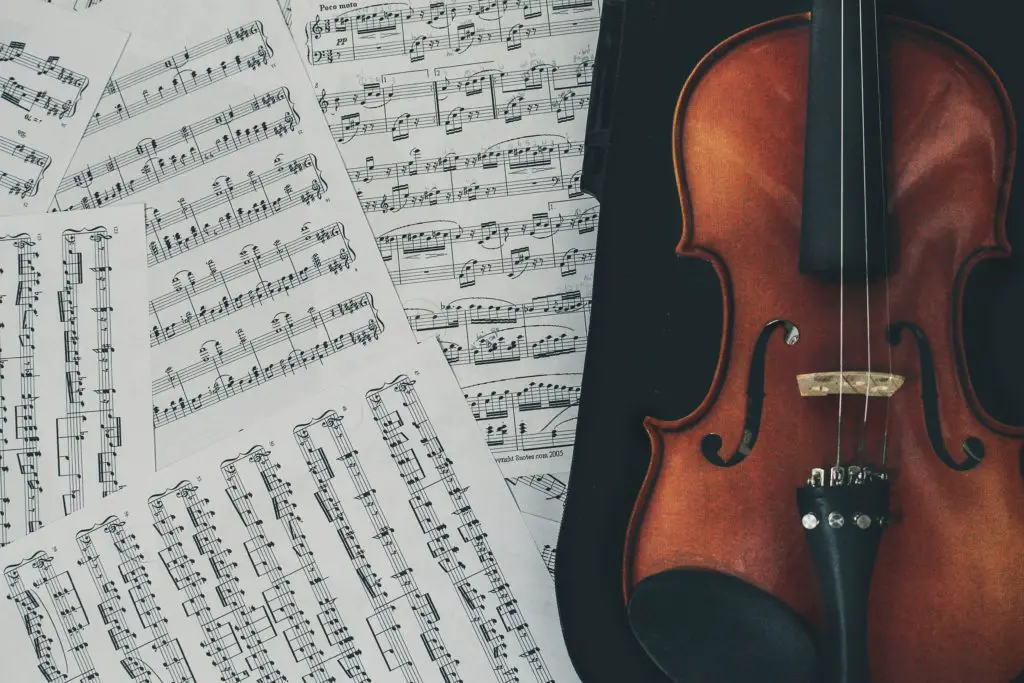For many aspiring violinists, learning how to play violin chords is extremely difficult. This blog post will answer your questions about playing violin chords.
Chords are rare for orchestra instruments like violins, as they are not considered to be chordal instruments. Because of the arc of the violin’s bridge, the bow cannot play all four strings at the same time.
String instruments are arranged in sections, which include violins, violas, and violoncellos. Generally, 3 and 4-way chords are distributed between the instruments in the section instead of being played by one violinist.
Chords on the violin are not played simultaneously like you will see done with a guitar or piano. When a single violinist plays a chord, it is normally played like an arpeggio, playing one or two notes at a time.

Table of Contents
Tips On How to Play Violin Chords
For a down bow chord:
- Give very little bow to the bottom double stop (less than one inch); reserving the majority of the bow for the top notes.
- Elbow position is critical. You want your elbow at the level where you’ll be ending the chord.
- If you give the bottom notes a lot of weight, they will continue to sound while you play to top notes.
- Make sure the bow is straight so you can get the best possible tone from your violin.
- Follow through with the bow to pull the sound out and make it ring.
For an up bow chord, the tips are the same, with one difference: Since you will usually be looking for a dramatic sound (a pop) with an up bow chord, use the extreme tip of the bow to make the bottom sound.
Watch this video to get a full lesson on playing violin chords:
Why Is It Important To Learn How To Play Violin Chords
Learning to play violin chords is a key component to mastering the violin.
This is because they can be used in so many different types of songs across all genres. Violinists use them for solo performances on classical pieces or for accompaniment during folk or country music performances.
Plus, learning how to play violin chords will give you the ability to improvise on any song that comes up in performance!
Why Is It So Important To Practice Your Violin Chords
The more you practice violin chords, the easier it will be to play them on a regular basis.
With practice, your fingers and hands will get used to moving around in certain patterns that make this process much simpler than when you first started practicing these skills.
What Kinds of Chords Can You Play On a Violin
There are many different types of chords that can be played on the violin. The most common ones include major triads, minor triads, and dominant seventh.
A major triad chord consists of three notes, such as C-E-G.
A minor triad chord has the same fingering positions except for one note that is moved down a half step so it will be played at fret number two instead of four like in major chords.
Dominant seventh chords consist of five different strings and include both major and minor triads combined together.
Can You Play Three Notes On a Violin
Most violinists cannot play three notes at once on the violin with a normal bow and pressure. What’s usually done by solo players is playing the notes one after the other in quick succession (arpeggio).
Do Violins Use Bar Chords
A bar chord is a type of open (string) chord played by barring one finger across two or more strings at once.
Violins do use bar chords. Violinists use the index finger of their left hand to hold down a string behind the violin’s neck while they pluck it with the right-hand fingers. Bar chords are often used in folk music and country music, but can also be found in other styles such as bluegrass and blues-rock.
Bar chords are notated with the letter “x” over the notes you should play. For example, if a chord is written as G/B x-xx-xxx, it means to play an open G string and then press down both the B string behind the head of your violin and low E strings on either side of it and pluck them with your right-hand fingers.
Chords can also be notated in the tablature; a way to represent the strings on paper that resembles the guitar tab. For example, “F/A” represents an F chord played by holding down both G and D strings behind the head of the violin while playing open A and E strings with the fingers of your right hand.
A classically trained violinist will typically learn to play bar chords in addition to the basic major and minor chords, playing them where appropriate in solos and accompaniment.
A beginning student should refrain from attempting the difficult task of doing this due to a lack of mobility and control on their left hand and fingers. These types of chords should only be attempted after learning how to play other types of string/fretboard chords with less overall stretching or barring required- such as simple power chords or suspended non-harmonic minor third intervals.
Resources For Playing Chords
Apps
Trala: This app is designed to help anyone (ages 4 and up) learn to play the violin.
MuseScore: This app provides free sheet music for the violin.
PlayAlong Violin: The app listens as you play your violin and helps guide you through the melody.
Books
Violin for Dummies (Amazon aff. link)
Violin/Fiddle Chords Scales Agreppios (Amazon aff. link)
Fiddling Chord Book (Amazon aff. link)
Conclusion
In this article, we’ve given some tips on how to go about learning violin chords as well as some resources you can use to learn to play chords.
Although learning how to play violin chords can be challenging at first, the more you practice them the easier it will become over time. Now that you know some of the basics of how to play violin chords, it’s time to practice, practice, practice! Good luck and we hope this guide has been helpful to you.

